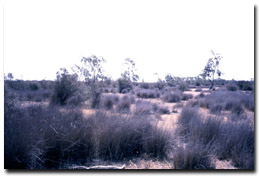Site 1 Lake Buloke
Site appears to be in environmental decline and is visibly salt affected
Description
Lake Buloke (Wildlife Reserve-Parks Vic.) is a terminal lake described as a Shallow Freshwater Marsh as it does not have a permanent period of inundation. Most of the lake bed dries out each year and totally dries out every 3-5 years. However, Lake Buloke has been dry since early 1998. The lake had previously been described as a Deep Freshwater Marsh by Heron et al (1991). All the streams in the catchment run into the Richardson River, which then terminate at Lake Buloke.
The site has an altitude of 100 m and is on an almost flat alluvial plain with lunettes to the east. The plain is the result of deposition of past sediments from the Richardson River and the Avoca River to the east. The lake bed has a long history of cropping and grazing and currently has 94 Perpetual Leases for agricultural purposes (Stimson 98).
The wetland is of high habitat value due to the diverse range of habitats available when water is present and large size of the reserve.
Vegetation Description and Composition This wetland is dominated by Eucalyptus camaldulensis (Red Gum) Open Woodland to the high water mark, with a Eucalyptus largiflorens (Black Box) Woodland above on the higher ground. The intact understorey is predominantly Muehlenbeckia florulenta (Tangled Lignum) and Eragrostis infecunda (Cane Grass). The two EVCs represented are Plains Grassy Wetland graduating into Plains Grassy Woodland outside the area of the lake bed. The area had comprised of 60% introduced species in 1997 with a gradual increase and this has now reduced to about 50% of the species present in 2002 due to dry conditions. The decrease in introduced species was mostly from the Asteraceae family. Cover abundance of the plant species present has also declined. Grazing pressure may also be a factor reducing number and abundance of species present. There were three salt indicator species present within the quadrats being Critesion marinum (Sea Barley Grass), Lolium rigidum (Wimmera Rye grass) and Enchylaena tomentosa (Ruby Salt bush). The vrot Muehlenbeckia horrida (Spiny lignum) was recorded. |  Looking out over Lake Buloke from the western edge in spring 2002 |
Tree Health
Eight trees are monitored for tree canopy health using a 20-point system assessing canopy size and density, number of dead branches and extent of epicormic growth. Leaf damage by insects is also assessed. Six trees have remained very healthy since monitoring commenced, however the other two have suffered rapid decline especially in the last twelve months and are now virtually dead. They had been totally defoliated by leaf skeletoniser caterpillars, contained many dead branches and extensive epicormic growth.
Water Quality
Lake Buloke dried up in February 1998 and only limited data is available. The one macroinvertebrate survey conducted in spring 1997 shown that Lake Buloke had medium quality water in terms of organic pollution. The presence of large numbers of Ostracods (Seed Shrimps) which are tolerant of large salinity increases may indicate that salinity levels are affecting taxa richness.
Groundwater and Salinity
There are three bores in the area, two are near the lake edge and suffer from gaps in data due to periodic inundation. They have both shown an overall rising pressure trend meaning that the deep drainage capacity in the area is seriously diminished. The other bore located further away from the lake has shown a downward trend in response to the lake drying up and the dry seasonal conditions. All bores recorded very high salinity readings in 2002 - >20 000 EC and are of concern if groundwater levels were to rise in the future. Saline groundwater intrusion into the Richardson River is having downstream effects when it flows from the site of intrusion to Lake Buloke.
Birds
Bird species present at the time of the vegetation and tree health surveys were :-
Brown Falcon, Brown Treecreeper, Galah, Magpie, Red-rumped Parrot, Starling, Superb Fairy-wren, Striated Pardalote, Tree Martin, Wedged-tailed Eagle, , Welcome Swallow, White-plumed Honeyeater, Masked Lapwing, Willie Wagtail, Magpie Lark, Galah and Boobook Owl (resting in a monitored tree).
Threats to the site continue to be:
- possible changes to natural flooding regime
- rising salinity levels from entire catchment
- extensive grazing and cropping reducing the site’s potential for natural regeneration
- continued tree health decline


